Care features
Some of the most important activities are soil moisture in the flowerpot and fertilization.
Pay attention that the ground is constantly slightly damp, but not waterlogged. Otherwise, the root system will simply start to rot, which will lead to the death of the violet.
Watering methods
There are 3 main ones. All of them are aimed at respecting the crown and root system, which is very sensitive to moisture.
- Top watering. It is carried out using a watering can with a long spout or a syringe. The main task is not to get on the surface of the leaves or in the center of the violet rosette, which can lead to putrefactive processes.
- Bottom watering. Take a container (bowl or small bowl), fill with water, and lower the bottom of the pot by 2/3. Wait a while for the soil to be saturated with water. When it shines, you need to pull out the flowerpot.
- Wick watering. Very convenient and optimal, because the plant itself controls the flow of moisture to the root system. Insert the wick into the pot. Pull one end through the drain hole in the bottom and lower it into a container of water. The circumference of the cord is 2 - 5 mm.
- To clean the dust from the plant, you need to periodically shower with warm water. After it, do not put the flower back on the windowsill until the foliage is dry. Otherwise, under the rays of the sun, the violet will burn up.
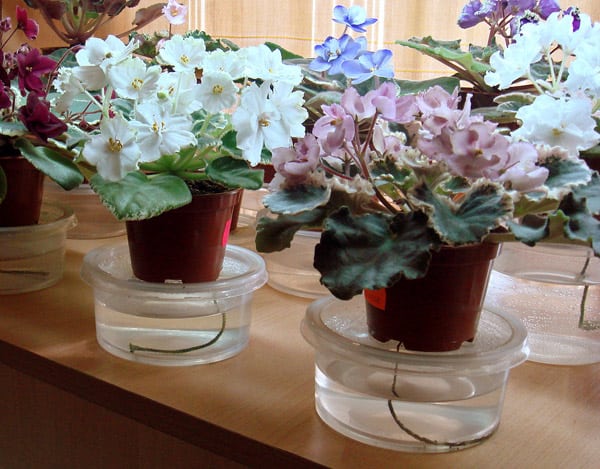
Fertilizer
It is better to use additional nutrients only in liquid form. Granular is poorly and takes a long time to be absorbed by the root system.
Once every 2 weeks, you need to feed the violet with nitrogen-containing substances during the growing season for the development of greenery and roots. In the budding and flowering phase, the plant will need phosphorus and potassium, which improve the quality and quantity of flowers.
Diseases and pests
An important procedure for caring for violets is disease prevention and pest control. Diseases affect the plant if the rules for caring for it are violated.
The appearance of the plant immediately signals the appearance of problems:
-
Brown spots on the leaves are late blight. The provocateur of the disease is the increased humidity of the soil and air, combined with cold. At the very beginning of the disease, spraying the plant with Hom, Oxyhom preparations will help. A plant that is severely affected by the disease cannot be saved, so it is disposed of.
- Brown petioles - fusarium. The cause of the disease is waterlogging of the soil, too dense soil, watering with cold water, sudden changes in temperature. It is necessary to treat a violet by spraying with Fundazol.
- White bloom on the leaves - powdery mildew. The reasons are lack of lighting, high air humidity, low temperature, lack of phosphorus and potassium in combination with an excess of nitrogen. It is necessary to treat a violet by spraying with copper sulfate or with the drugs Forecast, Topaz.
- Orange bumps and brown pads on the leaves - rust. The fungus develops on the leaves when the soil and air are waterlogged. The plant is sprayed with Bordeaux liquid.
- Gray plaque on the leaves - botrytis (gray rot). For treatment, the plant is sprayed with a fungicide.
- Folding the leaves inward - mites. All the leaves on the violets affected by the mite. Especially young ones start to deform. Flowers do not bloom, gradually dry out.
- Gnawed leaves and flowers are thrips. At the same time, the leaves are covered with brown or black dots. You can destroy thrips with Fitoverm, Aktellik, Aktara.
- Reddish brown spots and leaf deformation - mealybug. White insects can be seen in the axils of the leaves. The pest is destroyed with insecticides (Alatar, Aktara, Aktellik, Fitoverm).
- Sticky plaque and brown spots on the leaves are aphids. They destroy the pest by washing the violets with soapy water, and then spraying them with Mospilan, Aktellik, etc.

The appearance of a white coating on the plant itself and the soil indicates powdery mildew.
To prevent damage to violets by diseases and pests, the following rules should be adhered to:
- A violet purchased in a store is kept in quarantine for at least a month so that possible pests and diseases do not infect other plants.
- If you have any doubts about the health of a violet, it should be sprayed with Fitoverm or Fitosporin.
- The soil for transplanting must be decontaminated before the roots of the violet get into it.
- The violet should not be kept in a cold, damp place.
Transfer
Special attention should be paid to the rules of the "Creole" transplant. It should be borne in mind that Saintpaulia is actively developing in wide, but small containers. The optimum diameter of the pot is 8-10 cm, the volume is 0.3 liters. If a large pot is chosen for transplanting, then the florist may not hope for a quick flowering. The fact is that the violet begins to bloom only after its roots fill the entire volume of the container. The Creole needs a transplant every year. Young flowers are transplanted twice - in spring and autumn.
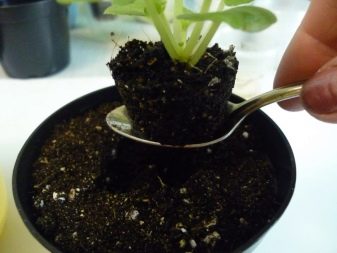

Saintpaulia prefers to grow in loose soil with a neutral or slightly acidic reaction. More often, experienced flower growers recommend buying a ready-made mixture with the addition of vermiculite or perlite as a soil for additional loosening. If the soil is prepared independently, then you can use the following recipe: mix peat (3 parts), leafy soil (5 parts), sand (1 part), sphagnum moss (1 part), vermiculite (0.5 part), charcoal (1 part).
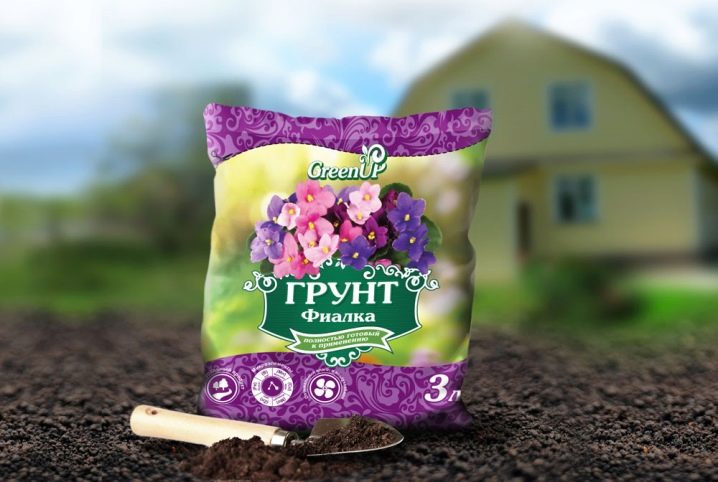
Do not use outdoor soil, as it contains a large amount of fungi, bacteria, larvae. Better to take land from a forest located far from the city. In order to rid the soil of larvae and microbes as much as possible, it is recommended to heat it in an oven or microwave. To transplant a violet, follow these steps.
Carefully remove the plant from the previous soil, inspect the roots for rotten and wilted parts. Wash off the soil from the roots, disinfect them in a weak solution of potassium permanganate. Remove lifeless parts. If after stripping the root system becomes smaller, then change the prepared new pot to a container of a smaller diameter.
At the bottom of the container, lay a drainage layer at least 4 cm high. Fill in new soil, deepen the plant to the lower leaves.
Cover the pot with perforated plastic wrap for a couple of days. This process will retain moisture in the soil.
You cannot water the flower for the first 2 days after transplanting.
If the plant needs an unscheduled transplant, for example, when the soil becomes acidic after waterlogging, then it is important to cut off all the flowers, since after transplanting the culture should spend all its energy on rooting and adaptation, and not on flowering.


Plant care

Variety of violets Lovely Creole is picky about watering.
The main activities for the care of violets are watering and feeding them. The soil in the plant pot should be slightly damp, but not wet. Waterlogging will cause rotting of the root system.
There are three ways to water a beautiful Creole:
- Top watering is carried out using a watering can with a long nose or a syringe. The purpose of these devices is to exclude the ingress of water on the leaves, and even more so in the center of the outlet. This will inevitably cause rotting of the plant.
- Bottom watering is carried out by installing the pot in a container with water. The immersion level is two-thirds the height of the walls of the pot. As soon as a moist gloss appears on the surface of the soil, the pot is removed from the water.
- Wick watering of violets is the most optimal watering option. A synthetic cord with a diameter of 2 to 5 millimeters is placed in the pot soil. The end of the cord is released from the drainage hole and placed in a container with water. With this type of watering, the plant regulates the soil moisture level on its own, absorbing water through the wick.
Once every 12-15 days, watering is combined with top dressing.During the growth of the rosette, nitrogen fertilizers are used, during the period of budding and flowering, phosphorus-potassium mixtures are used.
To maintain the purity of the leaves, the violet should be periodically washed with a light stream of warm water under the shower. After bathing, the plant is kept in the bathroom until the leaves are completely dry. It is impossible to expose a violet with wet leaves in the sun: the plant will get burns.

Violet Beautiful Creole is periodically fed with fertilizers.
Transplant rules
Practice shows that violets grow and develop best in wide, low pots. The maximum diameter of the pot is 8-10 centimeters, with a volume of 0.3-0.35 liters. Pans that are too large will acidify the soil and result in no flowering. Violets bloom only after the roots fill the entire space of the pot.
The room violet transplant procedure is carried out annually. Young rosettes are transplanted twice: in spring and autumn. During transplantation, the lower, dying leaves are removed from the outlet. The violet stem is buried in the soil to the level of the lower leaves.
The substrate for planting violets should be as loose as possible. With a neutral or slightly acidic reaction. An ideal option is a ready-made primer for violets with the addition of vermiculite or perlite for additional loosening. You can prepare the soil yourself by mixing peat (3 hours), leafy soil (5 hours), sand (1 hour), sphagnum moss (10% of the total volume). vermiculite (0.5 hours). To disinfect the soil, a small amount of charcoal is added to the mixture (10% of the total volume of the mixture).

The Lovely Creole violets love small pots.
A drainage layer with a height of at least 3-4 centimeters is laid at the bottom of the pot
When transplanting, the old soil from the roots of the violet is gently shaken off and the plant is placed in a new nutrient soil
The transplant is carried out in early spring or late autumn. If there is waterlogging, acidification of the soil, an urgent unscheduled transplant is necessary. All flowers are cut from the violet during the procedure, otherwise the violet will not have enough strength to root in the new soil.
After transplanting, the violet is not watered for 2 days until the roots adapt to the new soil. To retain moisture in the soil, the pot with the violet is covered with a plastic bag with small holes for air to enter.
Under what conditions to grow violets Beautiful Creole
If you are passionate about floriculture, then you will not experience any special difficulties growing this variety. The conditions of detention are the most common, similar to those needed for other varieties of violets.
It is advisable not to put the flowerpot on the south side of the room. For violets, bright, but diffused lighting is more suitable, which is easier to get in the east or west. In the summer, you need at least 14 hours, in the autumn - winter - 12 hours are enough.
If, nevertheless, the plant stands in the south of the apartment, then in the daytime, when the sun's rays are especially strong, the crown should be shaded to avoid the appearance of leaf burns.
If the pot stands in the north, in the shade, then the flowering can be much less in number, and the peduncles will be deployed in different directions.
In the cold season, it is recommended to use additional artificial lighting with fluorescent lamps or phytolamps.
From June to September, it is desirable that the thermometer be within +23 - 25 degrees, and in autumn and winter, the temperature can be reduced in the room to +18 - 20 degrees
If it is cool, then an amazing color change of the border occurs - it becomes almost a green hue.
It is important to maintain the desired level of humidity in the room - within 50 - 60%. If it is too low, the leaves may begin to dry out, and at a higher rate, the leaf plates rot.
For this reason, it is not recommended to spray them. They do not dry quickly due to hairiness.
To maintain the humidity in the desired percentage, install a decorative fountain, an aquarium nearby.In winter, when the air is dry thanks to heating devices, you can spray the area next to the plants, but the violets themselves are just watered.
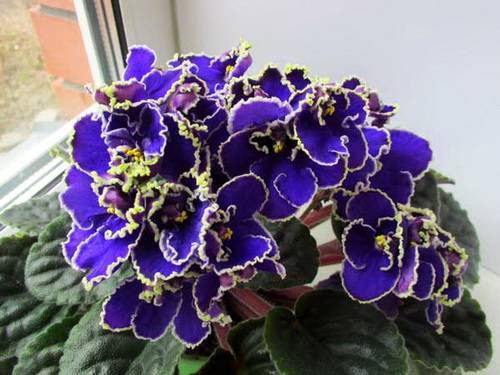
How to propagate
There are several ways that we will consider in more detail. After all, the reproduction of this variety is a necessary process.
Children
Violet The beautiful Creole is highly fertile. Indoor plant lovers need to know that flowering occurs only when all the stepchildren are separated from the mother's bulb. Therefore, it is necessary to separate the children once a year.
- Separated children must be transplanted into separate small cups, 100 g in volume and no more than 5 cm in diameter.
- When they grow a little, they should be dived into larger 200 ml cups. Young violets should be there until they bloom for the first time.
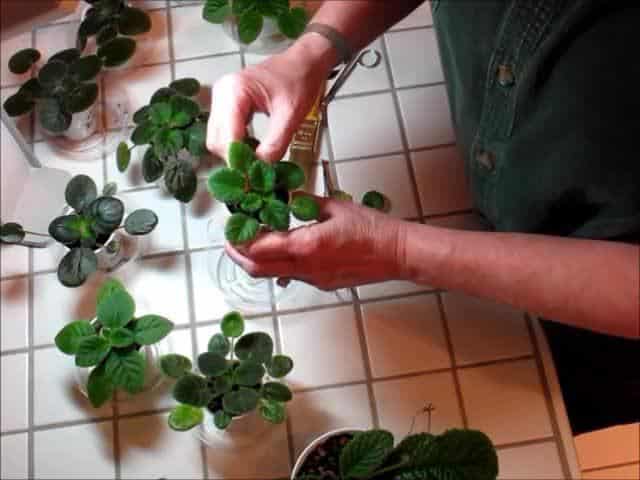
Leaflets
You can also try this method. For reproduction, you need to take sheets from the 2nd row. They are most suitable for rooting. It is not recommended to take from the first, from the middle of the outlet, or from the third, in which the leaves are old.
It is important to find a leaf that is free of any stains, shrinkage, or signs of decay. You need to cut with a very sharp knife or blade at an angle of 45 degrees
The instrument must be disinfected.
The leaf can be placed in a glass of water or planted directly into the ground. Planting depth - no more than one and a half centimeters. Then the stalk will not rot.
If the stalk is in the water, then watch when the roots appear 2 cm long. After 4 weeks, the children are formed. Next, transplant into a nutritious soil mixture when the height of the cuttings of the children is at least 4 - 5 cm.

Variety of violets Beautiful Creole. How to properly care for a plant
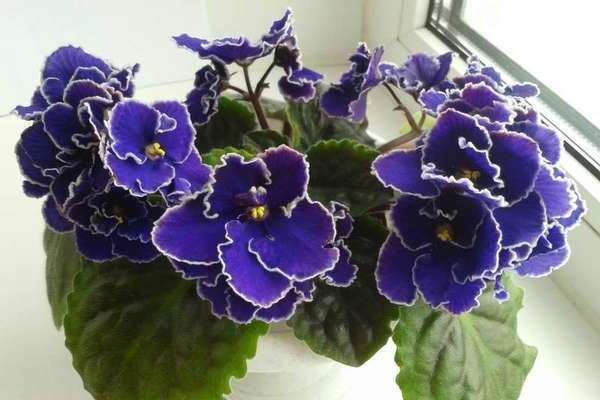
Photo of the violet variety Beautiful Creole
Of course, the Beautiful Creole violet does not belong to the most unpretentious plants that can survive even if they are completely deprived of the owner. Therefore, if you want to watch her wonderful flowering longer, you will have to take very good care of her and provide her with the best conditions. Therefore, we offer you detailed instructions that will tell you how to do this.
Lighting
First of all, you will have to take good care of providing good lighting for this plant, since it is it that largely determines how long and how brightly the violet will bloom. To begin with, you will need to make sure that this plant has at least fourteen hours of daylight hours. However, this time is relevant exclusively for the summer. In winter, a ten-hour sunny day is quite enough.
As for the light itself, it should be moderately bright. However, this does not mean that direct sunlight will do the plant a good service. The fact is that being under the scorching sun can be dangerous for the Beautiful Creole violet variety, and therefore the location on the windows of a southern orientation is completely contraindicated for it. It would be much better to choose a west or east window, on which the sun's rays will not cause significant damage to the violets LE-Lovely Creole.
However, even on the south window it is quite possible to provide the Beautiful Creole violet with suitable conditions. However, you need to understand that for this you will have to significantly reduce the lighting in the entire room by covering the window with a special film. Few people want to do this for the sake of just one flower, and therefore the western and southern orientations, of course, are preferable.
Temperature regime
It should be noted that to grow this plant, you definitely do not have to turn your home into a real greenhouse or, conversely, live in constant cold. Violet Beautiful Creole lives wonderfully at room temperatures, and, accordingly, if you feel comfortable, then she will feel comfortable.
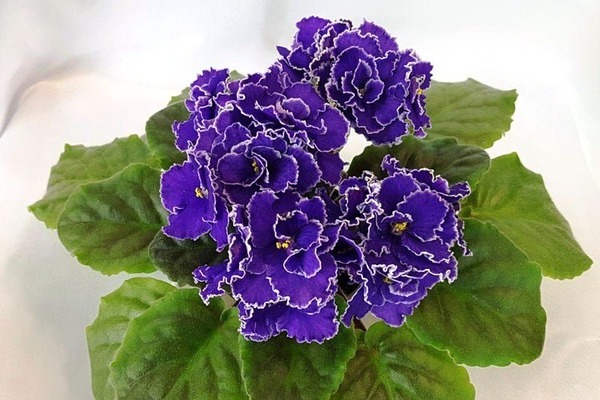
Violet Lovely Creole: photo of the variety
This state corresponds to temperatures from twenty-three to twenty-six degrees Celsius. Roughly the same applies to winter, when the plant begins a dormant period. At this time, the optimum temperature will be either eighteen or twenty degrees Celsius.
However, being on the windowsill at this time will be extremely undesirable, since it is under them that heating elements are most often located, which can extremely harm the plant with their heat. The same goes for the flowering period, by the way. Since if during it too high temperatures affect the LE-Beautiful Creole violet, there is a considerable chance that the flowers will turn out to be dull and will not have a lace border, as we have already told you about earlier.
Humidity
Humidity to provide ideal conditions for this plant should also not be sky-high. Values from fifty to sixty percent are quite enough for you. However, if your home is dry enough, you can get an automatic sprayer and set it to the lowest setting.
However, you must be very careful, and you should also never spray the plant with a spray bottle or wipe it down with a damp cloth. The same goes for positioning the sprayer too close to the plant.
The fact is that the leaves and petals of the violet Beautiful Creole have a fleecy structure, and therefore the water, falling on them, will linger there for a very long time and will definitely not evaporate in the near future. And water is an ideal place for the growth and development of all kinds of fungi that will not miss the chance to get into your plant and begin the process of its decay.
That is why you will definitely have to give up manual spraying. If the room is too dry, a container with water placed next to the plant can help you, since moisture will gradually evaporate from the surface and spread throughout the room.
Violet, description and photo of LE-Beautiful Creole (E. Lebetskaya)
Violets of breeders of the CIS countries - "P" (LE-2).
LE-Beautiful Creole (E. Lebetskaya).
LE-Beautiful Creole, LE-Prekrasnaya Kreolka (E. Lebetskaya).
Large semi-double dark blue curly stars with a wide “fat” wavy fringe. The sport Tasya (O. Stulenkova) Chimera is assigned from him.
Green quilted leaves. Standard and not at all small. Neat, symmetrical rosette with beautiful leaves.
Very unusual flowers. Flower color - deep blue, saturated color. Very bright green ruffled border. Flowers 5 cm. In hot weather there is little green border. In cool conditions, the ruffle of this variety is more intense.
It blooms with a bouquet, a big hat does not work. The variety blooms for a long time (more than a month) and often. Flowers open for a very long time before complete dissolution. The flower stalks are strong, they stand like soldiers, there are a lot of buds on each peduncle. Peduncles gather together in a bouquet. With a lack of light, the peduncles look in different directions.
Early flowering. The variety is very prolific - it gives out children quickly and a lot, children grow up quickly.
What is the difference between a variety and a sport ?. Sport is separate and according to foliage and flowers. The difference is this - the sport differs both in the size of the outlet - it is much larger, and in the leaves - they are more corrugated, curly. The straighter the leaf, the smoother the edge of the flower. The reverse side of the leaf in the variety is slightly reddish, and in the sport it is almost cherry.
The flowers are dark blue-violet, with a thick fringe, they do not fully open and the border is not white, but yellow-green. There is also a light sport, but his flowers turn brown from the inside literally for 5-7 days. If the baby has wavy leaves, then there will be sport. The variety is more compact, bright blue. And the border is not so fluffy on the flowers. The leaves are straight in the variety.
Creole (from French crеole; Spanish criollo; Latin creare “to create, cultivate”) is an ethnonym that has different meanings.Descendants of European (Spanish, Portuguese, less often French) settlers in the territories of the colonies in North and South America. In Brazil and the West Indies - the descendants of black slaves. Accordingly, in the feminine gender, the word will be like "Creole".
Do you know that…?
If damaged by any mite, the leaves are bent inward, the plant does not bloom. The growth of the affected plants is slowed down. Thickening of the center of the rosette. The riveted centers do not have the straightened edges of the central leaves, they are always tucked up. In the center of the rosette, deformed leaves appear, curved and small, shagreen, finely punctured surface of the upper part of the leaf blade - the leaves fold in the form of a boat, on shortened petioles. Young leaves are crowded and deformed, as if curling, wrinkling, becoming very fluffy. The buds do not develop. Flowers on diseased plants do not bloom to the end, they become deformed. Over time, the plant dies.
Before buying the violets listed below, carefully read their behavior on the windowsill on the forums. Many of them are very beautiful flowers. However, it can be large rosettes with large and fragile leaves, with leaves rising upward or hugging the pot, form many stepsons interfering with the formation of a neat rosette, pulls the stem up and grows into a herringbone, bending the trunk, rare flowering with long breaks, flowers that fall off or keep a little and wither quickly, very long and recumbent peduncles, the color of the flower quickly fades, they do not like bright lighting on the windowsill, they are afraid of the slightest drying out or waterlogging, a large percentage of sports or the darkening of the flower.
Are they suitable for your windowsill and the conditions you can create for them? You will be looking at flowers for several months, and the rosette is always in front of your eyes. There are many beautiful flowers, beautiful and neat outlets are much less, look first of all at the outlet! Search and you can find a dozen violets with the same color of flowers, if you are not interested in the smallest details, as a collector.
• - Parisian Mysteries (Lebetskaya); • - First Maid of Honor (Lebetskaya); • - Primrose (Lebetskaya); • - Snowdrop (Lebetskaya); • - Field of Miracles (Lebetskaya);
Description of morphological features
- The petals of flowers are simple or semi-double, large in size - a circle of about 4, 5 - 5 cm. Each petal is surrounded by ruffles and a rim of a whitish-greenish tone, which makes the flower itself stand out against the background of bright greenery. It is the curliness of the flower with a pronounced fringe that attracts lovers of this indoor plant.
- During the flowering period, the plant forms a blooming bunch, but does not form a blooming thick "cap". This variety blooms in waves. Each for a month or a little more. Peduncles are strong, dark pink in color, hold the bud well. When the flower opens, they may bend slightly. On 1 peduncle, 5 to 7 flowers bloom in turn.
- The leaves are dark saturated green, slightly pubescent or quilted. A slight waviness can be seen along the edge of the sheet plate.
- The outlet itself is quite compact, it develops symmetrically, the diameter is 25 - 35 cm.

Conditions of detention
In order for the violet to please with abundant full-fledged flowering, it is necessary to provide it with the correct conditions of detention.
Provide the Creole with 14 hours of daylight in the summer and 10-12 hours in the winter. For natural, moderate light, it is recommended to place the flower pot on the east or west side
If the culture is grown on a south window, then it is important to create a shady area for it, otherwise ultraviolet rays can provoke burns on the leaves. In winter, experienced florists advise using phyto or fluorescent lamps.
The optimum temperature at which the variety will feel comfortable is + 23 + 25 degrees in summer and + 18 + 20 degrees in winter.
Keep in mind that under too warm conditions during flowering, the violet will not be able to please with the most vivid beauty of the buds.
The moisture index for growing "Creole" is 50-60%. To achieve the desired level, you can systematically spray water in the room. Try to avoid getting water on the plant. Violet leaves have a fleecy texture, which is why water stays on the surface and does not evaporate for a long time, which can lead to decay. Household air humidifiers and decorative fountains will also help maintain humidity levels. Even a container of water placed next to the pot will help to save the situation in a dry room.


